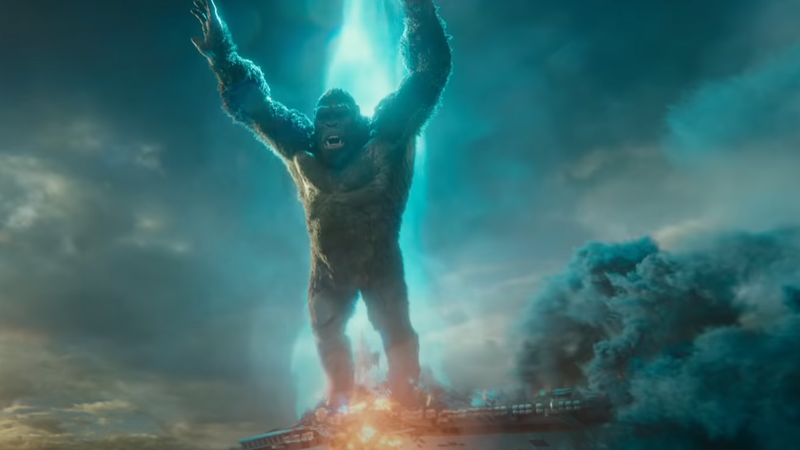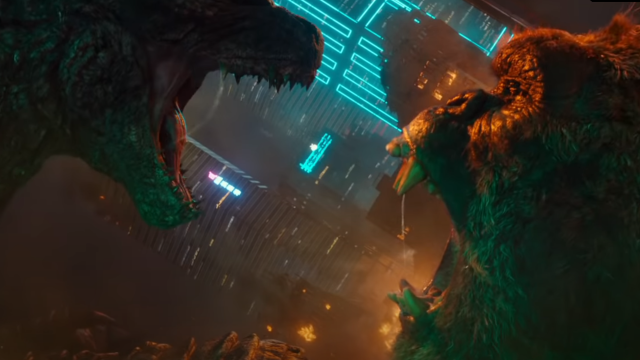Godzilla vs. Kong is nearly here, and it’s a clash for the ages: two of the box office’s most beloved giant monsters, at each other’s throats again like it’s 1962. But the movie isn’t just a rematch between titans, for director Adam Wingard, it’s a step up to a truly titanic level of blockbuster moviemaking.
Inheriting not just what was left behind by Kong: Skull Island and two Godzilla movies as part of Legendary’s fledgling “Monsterverse”, but the legacy of two of moviemaking’s biggest legends, literally or otherwise, Wingard — best known for small-scale, taught action-horrors like You’re Next and Netflix’s Death Note adaptation — has been thrust onto a gigantic stage.
[referenced id=”1674889″ url=”https://gizmodo.com.au/2021/02/godzilla-and-king-kong-are-legends-first-monsters-second/” thumb=”https://gizmodo.com.au/wp-content/uploads/2021/02/25/efcu10rsyuijjibi3lz6-300×169.png” title=”Godzilla and King Kong Are Legends First, Monsters Second” excerpt=”There was plenty to like about how Jordan Vogt-Roberts’ Kong: Skull Island and Michael Dougherty’s Godzilla: King of the Monsters spent ample time playing to the visual majesties of their respective kaiju. But both movies suffered dearly whenever their focuses turned toward the human characters, whose relatively insignificant dramas were meant…”]
To find out more about his approach to dealing with such enormous figures — from juggling a massive cast of humans to polishing the movie off just as the covid-19 pandemic took hold, sending studio employees to work from home — Gizmodo caught up with the director on a video call. Check out the interview below!
James Whitbrook, Gizmodo: You’re inheriting two very sizable movie franchises and smashing them together in Godzilla vs Kong. What did you want to see in this movie you felt like we hadn’t seen in either Skull Island or Godzilla and King of the Monsters?
Adam Wingard: I think the main thing I wanted to see is…I wanted to get to the heart of those characters. I wanted to feel the emotions from the monsters, you know? I think all the Monsterverse films have done such a great job of giving us all these different kinds of directorial points of view — they’re sort of these blockbuster auteur films, in a way. Like, everybody gets to do their very own specific take. And for me going into it, I really felt it was most important…I wanted to get back to what I think these movies kind of originated in, which is a feeling of real empathy for the monsters.
I went back and watched all the Godzilla and King Kong movies right away when I was even in the early phases of negotiation on the film. And one of the things I was struck with was how emotional they could be, sometimes — even Godzilla movies, which you wouldn’t think. Godzilla vs Destoroyah, for instance. There’s a moment there where Junior — little baby Godzilla — dies, and Godzilla kind of mourns for it, and there’s this really sad music playing. That was a big wake-up call for me, because I thought, ‘Here we are with guys in suits’, you know? It shouldn’t be emotionally arresting, but here I am getting teary-eyed because of the power of cinema. The way they were juxtaposing the images with the music and things. And Kong has always had that, because he’s always just been a more empathetic character in those older movies. So, that was probably the main thing. In addition to, like, the colours — the crazy, ‘80s tonal things I like to bring to my movies, and the music, and everything. The heart of it was what I wanted to explore.
Gizmodo: Kong is very much the primary perspective when we are brought into the movie. Can you talk about the decision to frame this through his lens more so, and Godzilla as an outside, antagonistic force?
Wingard: Godzilla has always been this pendulum of a character, traditionally. He’s gone from bad, to good, to bad again and that’s just the way we’ve always perceived him. And the Monsterverse version, he’s always been a good guy. So, it’s always been just a matter of time before something happened and Godzilla was going to be seen as a villain — or a heel, I think, is the more accurate term in this film. So, that just naturally creates a bigger mystery around Godzilla: once you’re the villain, you can’t just stick with them all the time.
He has to be a little bit more mysterious. He gets a lot of great screentime in the movie, but ultimately that kind of forces us to imprint on Kong as a bit more of the protagonist. It just kind of naturally created this sort of underdog status for Kong, as well. Because here’s this thing out there that seems unstoppable and is destroying half of the world. ‘What do we do?’, and here’s Kong as this sort of very empathetic type of character. So, the story naturally lends itself to pushing him in that direction.

Gizmodo: Aside from the shadow of these two literally massive monsters you’ve got such a large cast to deal with. New characters, the villains, returning characters from King of the Monsters — what was the biggest challenge for you finding the impetus to bring these two universes together?
Wingard: I think anybody who looks at my films, you can kind of see I have an obsession with efficiency, pacing, and tone. Sometimes, maybe, I go through things too fast because maybe I have ADD or something, but I’m very impatient. I feel like Hollywood blockbusters, they kind of loosen up too much sometimes. We’ve got to a point where it’s very casual to see a movie at two-and-a-half hours, but, boy, I feel like you have to really, really have something going on for it to be over two hours. And with Godzilla vs Kong, I just thought the audience that’s going to want to watch this doesn’t want to sit in a theatre for two and a half hours. They want a dense, exciting experience they can get excited about. They want to run out of the theatre with energy, not worn down.
So, I would say the biggest challenge for me was just the fact that, like, I have all these characters and am also technically doing a sequel — but I’m doing a sequel that needs to stand alone. You need to be able to watch this film without ever seeing the other films. The biggest challenge is always the first half-hour of the movie. It’s like, ‘How do we set up all these things but keep it very enjoyable?’ Because once the movie hits the half-hour point, it’s just non-stop action from there. The movie never slows down.
But it was always important that even when we’re setting things up that the movie doesn’t have a stagnant feel — and also, most importantly, that you’re never that far away from the monsters. It was always important to me that you’re always going to get a little glimpse of a monster in every single scene. Even if it’s just setting them up, and the exposition around them. All the actors brought so much to it, they knew the characters, they knew the personalities that they’re bringing in — everybody’s very colorfully designed and easy to keep track of. And they can make a splash very quickly and efficiently.
[referenced id=”1676571″ url=”https://gizmodo.com.au/2021/03/the-long-history-of-godzillas-cinematic-looks/” thumb=”https://gizmodo.com.au/wp-content/uploads/2021/03/03/z8tonavcggoqjognjs92-300×169.png” title=”The Long History of Godzilla’s Cinematic Looks” excerpt=”Godzilla isn’t just a monster movie icon, the king of all kaiju: he is a king of looks too. In the nearly seven decades he’s been stomping around the box office, Godzilla’s gone through more appearances than most cinematic legends ever could. From his earliest days to his upcoming smashup…”]
Gizmodo: You’ve done action movies before — but there was nothing quite on the scale of this. What was that experience like for you as a director, not just coming into this huge blockbuster, but we’ve been working through the last year in very strange, weird times. You’ve dealt with this scale, but dealt with it in such a unique way.
Wingard: Fortunately, for me, just to speak to the latter half of that — the pandemic hit us directly at our post-production facility in March. That’s when we started having to work remotely, but we were in the very final phases. I think we had about a month and a half, or maybe two months left, of post-production. We hadn’t locked the picture by that point, but we were pretty close to it. So working remotely wasn’t too bad. There were a lot of special effects reviews that had to happen over — I can’t remember which program we were using — we had a special program where we were able to monitor online. And then once a week or every two weeks, I was able to go into Legendary with just me and Alex Garcia, the producer, and we were able to watch it on the big screen when we were giving our final okays — we saw it on the big screen because that was important to do.
In terms of developing the film, I’ve done a lot of action, but never on this scale. In a lot of ways, the action was the easiest part of this movie. Like I mentioned before, setting up the film and getting past all those storytelling efficiencies were the most difficult, but what’s great about when you’re working on a movie like this is that for the first time ever, here I am, this indie director used to developing scripts with the budget in mind — where you can’t just say ‘A house explodes’ during an action scene — you have to say, ‘Well, we know what we can and can’t afford, and how do we have to write towards that,’ you know? And with this film, you’re kind of asked to use unlimited imagination. That’s what’s so exciting about it. I got into making movies because of big, sci-fi spectacles like the Star Wars films and the Alien movies, and those kinds of things. So, I always wanted the chance to flex my imagination and create these new worlds and environments and things.
That was actually very fun and intuitive, honestly, because you’re working from a process that takes a long time and there’s lots of steps to it. As you go, you tweak and tweak and tweak. It’s actually very intuitive, as a director. You start with a storyboard, and then you go to a preview, and once you’ve locked in that animation, there’s just different phases of animation that get more and more detailed as you go. The hardest thing is in the early phases of doing that is learning that once you get to a certain point, you’re spending a lot of money and not allowed to go back. So, you really have to know this is the right decision because if you don’t, it’s going to cost the same amount of money to go back and redo it. Like, for instance, if you don’t like the angle that you’ve chosen once you’ve seen it more fleshed out — suddenly it’s like, ‘Well, sorry. We’ve already spent $US18,000 ($23,780) on this shot, and we’re just getting started, so…make up your mind!’ You have those kinds of moments which are a little scary, but by and large, that part was just so fun for me. I’d love to do another one of these big monster movies.
Godzilla vs. Kong is now in Australian theatres.
